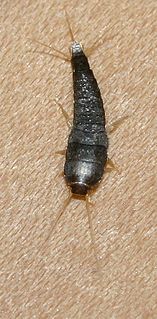
Lepismatidae is a family of primitive wingless insects with about 190 described species. This family contains the two most familiar members of the order Zygentoma: the silverfish and the firebrat. It is one of five families in the order Zygentoma.

Ctenolepisma is a genus of primitive insects in the order Zygentoma, closely related to the silverfish and firebrat but less reliant on human habitation, some species being found both indoors and outdoors and some found exclusively outdoors. The genus is distributed nearly worldwide in warm regions. Australia lacks native Ctenolepisma, but is home to introduced species.

Ctenolepisma lineatum is a species of insect of the order Zygentoma. It is generally similar to the closely related silverfish but can be distinguished by being rather stouter and less shiny with all appendages noticeably longer. The abdomen is often marked with dark brown lines and the species is sometimes called four-lined silverfish.
Sceletolepisma albidum is a species of silverfish in the family Lepismatidae.
Ctenolepisma algharbicum is a species of silverfish in the family Lepismatidae.
Sceletolepisma canariense is a species of silverfish in the family Lepismatidae.
Ctenolepisma dubitale is a species of silverfish in the family Lepismatidae.
Ctenolepisma electrans is a species of silverfish in the family Lepismatidae.
Ctenolepisma guadianicum is a species of silverfish in the family Lepismatidae. Like all silverfish, guadianicum prefers very humid environments, although some members of Thysanura have evolved minor adaptations to alter this. Guadianicum, similar to the vast majority of the near four hundred discovered silverfish, lives outdoors, under detritus, leaves, and other fallen forest debris. This silverfish is grey in appearance, less than an inch long, with an oblong body shape. All members of Ctenolepisma have lengthy, angled antennae that extend from their head and reach towards their abdomen. Guadianicum also lacks wings, has three pairs of legs, and has abdomen appendages appearing similar to antennae. Unlike the indoor dwelling silverfish species, guadianicum is not considered a pest, however, this means that little else is known about this particular species discovered in the 1990s.
Ctenolepisma guanche is a species of silverfish in the family Lepismatidae.
Ctenolepisma hummelincki is a species of silverfish in the family Lepismatidae. It is found in the Caribbean Sea.
Ctenolepisma insulicola is a species of silverfish in the family Lepismatidae.
Sceletolepisma michaelseni is a species of silverfish in the family Lepismatidae.
Sceletolepisma rodriguezi is a species of silverfish in the family Lepismatidae.
Ctenolepisma rothschildi is a species of silverfish in the family Lepismatidae. It is found in Africa, Australia, the Caribbean Sea, Europe & Northern Asia, Central America, North America, Oceania, South America, and Southern Asia.
Ctenolepisma tanzanicum is a species of silverfish in the family Lepismatidae.
Ctenolepisma targionianum is a species of silverfish in the family Lepismatidae.
Ctenolepisma terebrans is a species of silverfish in the family Lepismatidae.
Ctenolepisma versluysi is a species of silverfish in the family Lepismatidae.
Ctenolepisma vieirai is a species of silverfish in the family Lepismatidae. It is found in Europe.


